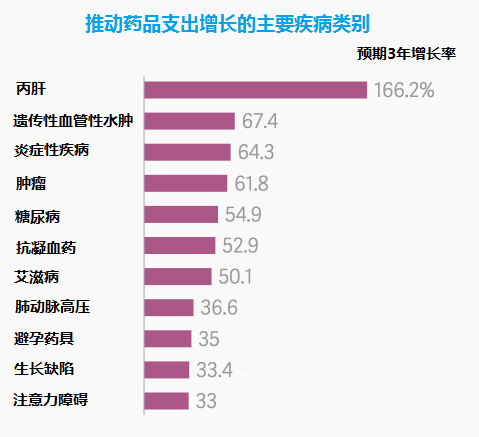2015年3月25日讯 /生物谷BIOON/ --行业观察家都知道,美国的药品支出正在大幅上涨。他们也知道,如果不发生一些重大变化,未来数年该国的药品支出将继续增长。但究竟是哪些疾病推动了这一狂潮?下面的一些数据可能会让你大吃一惊!
根据药品价格及药物使用率的预期增长,行业网站Quartz统计出了未来3年药品支出增长最快的疾病清单。首当其冲的是丙肝,未来3年这方面的药品支出预计将增长166%,这一点多少在意料之中。根据Express Scripts本月发布的药品支出报告,来自吉利德和艾伯维的丙肝新药使丙肝治疗方面的支出增长幅度达到了历史性的742.6%。

而榜单中排在第二位的疾病——遗传性血管性水肿(HAE),则多少令人惊讶。根据Quart的清单,在未来3年该病方面的药品支出将增长64.7%,尽管在美国该病的患者总数仅1.8万例。
不过医药行业都知道,罕见病药物的价格通常都非常昂贵,比如夏尔(Shire)公司的HAE药物Cinryze在美国的治疗成本高达23万美元/人/年,位列《2014年最昂贵的10大药品》榜单第4。紧跟其后的也是一系列罕见病药物,包括Alexion公司的Soliris,BioMarin公司的Naglazyme,Vertex公司的Kalydeco。而在2013年以42亿美元高价收购ViroPharma获得Cinryze之前,Shire自己也有一款HAE上市,该款药物Firazyr是一个与Cinryze互补的产品,用于治疗HAE的急性发作。而CLS Behring、Dyax和Salix制药,也有针对该疾病的药物,这3家公司最近已同意被Valeant收购。
炎症性疾病、癌症、糖尿病这3大疾病分别位列Quartz清单第3、4、5位。该名单上的其他疾病还包括肺动脉高压,拜耳公司新近获批的肺动脉高压药物Adempas预计将大幅增长。
不过,一些纳税人也有其他计划。北美最大的药房福利管理公司——快捷药方公司(Express Scripts)便是其中之一,该公司已与艾伯维就一份独家协议进行了谈判,并触发了有关丙肝药品的一场价格战。该公司CMO Steve Miller表示,计划采用同样的战略,打击其他疾病领域(如癌症)不断增长的药品价格。
英文原文:Which diseases are driving drug spending hikes? It's not just hep C
Industry watchers well know that U.S. drug spending is rising--a lot. And they also know that it's likely to continue over the next few years if some major changes don't occur. But which medical conditions will be responsible for the swelling tide? Some of those may surprise you.
Using the expected increase in cost per dose and the rates of use for drugs, Quartz has compiled a list of the maladies with the fastest expected growth in spending per patient over the next three years. Topping the chart is hepatitis C, with an estimated 166% three-year increase. That won't surprise those who read Express Scripts' ($ESRX) drug spending report earlier this month, which said new treatments from Gilead ($GILD) and AbbVie ($ABV) took hep C spending up by 742.6% last year.
Second place on Quartz's list, though, may raise a few eyebrows. Per-patient spending on the rare genetic blood disorder hereditary angioedema (HAE) will increase by 67.4% over the measured period, despite the fact that it only affects one in 18,000 people in the U.S.
As pharma knows, though, rare-disease drugs often come with high price tags--like Shire's ($SHPG) HAE med Cinryze, which made FiercePharma's most recent list of the top 10 most expensive drugs. Its $230,826 per U.S. patient per year price tag ranked it at No. 4, behind fellow rare-disease treatments Soliris from Alexion ($ALXN), Naglazyme from BioMarin ($BMRN), and Kalydeco from Vertex ($VRTX).
And before acquiring Cinryze--which it did with 2013's ViroPharma buyout--Shire already had another HAE drug in its own brand stable. That med, Firazyr, treats acute attacks of swelling in HAE patients, making it a complementary product to Cinryze, which is used to prevent them. CSL Behring, Dyax and Salix Pharmaceuticals--which recently agreed to be acquired by Valeant ($VRX)--also make products for the disease.
Also appearing on Quartz list are inflammatory conditions at No. 3--sure to be propelled by new psoriasis med Cosentyx from Novartis ($NVS) and the onslaught of Big Pharma pipeline rivals set to follow--cancer at No. 4, and diabetes at No. 5. Further down the list, the conditions include pulmonary arterial hypertension, a disease Bayer has tagged for growth with new therapy Adempas.
Some payers, though, have other plans. Express Scripts, for one, has rallied against skyrocketing hep C prices by negotiating an exclusive deal with AbbVie and touching off a pricing war. CMO Steve Miller says he plans to apply the same strategy to combat rising costs in fields like cancer.
